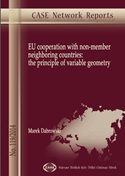EU cooperation with non-member neighboring countries: the principle of variable geometry
 Since the beginning of its existence, the European Union (EU) has been trying to build close economic and political relations with non-member countries. A variety of legal forms has been used, as the EU has always been flexible in offering or accepting the exact cooperation model, trying to adjust itself to the specific needs, constraints and sovereignty concerns of individual partners. The organization has never pushed any country to join its structures or sign association or free trade agreements. The EU’s experience in building a complex and flexible net of economic and political relations with non-member countries can serve as a good lesson and example to follow by other regional integration blocs that face the problem of shaping their external relations with countries that are interested in close cooperation but not membership in a given bloc.
Since the beginning of its existence, the European Union (EU) has been trying to build close economic and political relations with non-member countries. A variety of legal forms has been used, as the EU has always been flexible in offering or accepting the exact cooperation model, trying to adjust itself to the specific needs, constraints and sovereignty concerns of individual partners. The organization has never pushed any country to join its structures or sign association or free trade agreements. The EU’s experience in building a complex and flexible net of economic and political relations with non-member countries can serve as a good lesson and example to follow by other regional integration blocs that face the problem of shaping their external relations with countries that are interested in close cooperation but not membership in a given bloc.
The purpose of this study is to analyze the experience of the European Union in cooperation with non-member neighboring countries, to which the EU’s integration process and institutions are both available. On the one hand, several non-member countries are interested in close cooperation or integration with the organization because of their future membership aspirations or simply because they consider the EU an important economic and political partner. On the other hand, the EU itself is also interested in building such close relations, for economic but often also for geopolitical and security reasons.
The publication, written by Marek Dabrowski, can be downloaded here.

